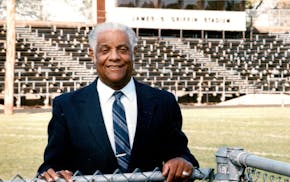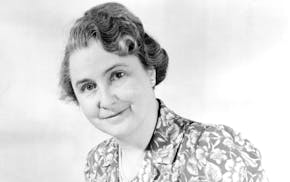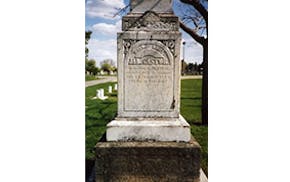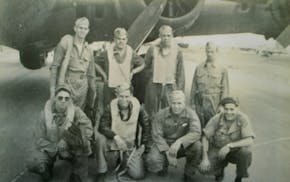Many of Minnesota's early settlers were lumbermen from Maine who had cut down forests back East — their axes and saws sharpened and hungry for more pines.
Benjamin Franklin Upton was different. When he moved in his 30s from Maine to Minnesota Territory in 1856, he thirsted to capture frontier images through his photography.
"He traveled about the state in a wagon especially built to carry his photographic equipment and camping gear, shooting priceless views of Minnesota people and scenes," wrote the late Alan Woolworth, a Minnesota Historical Society historian and archaeologist.
During his nearly 20 years in Minnesota, Upton developed thousands of negatives in his custom-equipped, horse-drawn wagon. "He made many views of lasting historical value to Minnesota," Woolworth wrote.
Upton's surviving collection includes portraits of Ojibwe and Dakota people, including those incarcerated at Fort Snelling after the U.S.-Dakota War of 1862. Upton snapped panoramic landscapes of St. Anthony Falls and St. Paul, photographed soldiers heading off to the Civil War and captured images of river bridges and the 1860 State Fair at Fort Snelling.
Now, 112 years after Upton's death at 92, nearly four dozen of his images are being sold at auction April 27. They belonged to railroad baron James J. Hill and were housed at his stately reference library in St. Paul, which opened in 1921 but shut its doors in 2018 and was sold last year to historic preservation real estate developers.
Most of the images of waterfalls, Red River carts and landscapes are expected to fetch from $200 to $400, with opening bids set at $25, according to the Revere Auctions online catalog (tinyurl.com/UptonAuction, Lots 39-68). The modest prices reflect the fact that Upton's photographs are widely held, including in collections at the Minnesota Historical Society, the Library of Congress, the Smithsonian and even the British Museum.
However, bidding starts at $500 for Lot 62: Upton's 1862 photograph showing river mist shrouding Fort Snelling's fenced yard of tepees where Dakota refugees were being held after the six-week war (tinyurl.com/UptonFort).
"That particular photograph is extraordinary — a rare moment of time," said Sean Blanchet, co-owner of St. Paul-based Revere Auctions. "With so much attention now focused on Native American history and the conflict, and the photograph's incredible detail, that one is just riveting."
Born in 1818 in Dixmont, Maine, Upton launched his career working with daguerreotypes — the forerunner of the photographic process. He arrived in St. Anthony, the riverfront village that preceded Minneapolis, in 1856 and soon moved to Big Lake with his wife, Sarah, and the first three of their five children. They also spent time at a cottage on Lake Minnetonka.
Unlike most of that era's photographers who snapped portraits in their studios, Upton made his living venturing out in the field for images of Minnehaha Falls, Native Americans, soldiers and other subjects in the state's early years.
Upton moved to Florida in 1875 but visited Minnesota in 1901 at 82, when he explained his process to fellow photographer Edward Bromley. Considered Upton's biographer, Bromley saved and preserved early Upton albums and donated them to the Minnesota Historical Society.
In two 1901 stories in the Minneapolis Sunday Times based on interviews with Bromley, Upton told how he converted his wagon to a portable darkroom, schlepping along pieces of glass and chemicals to develop negatives.
"He would hitch up his horse, drive to the point where he was to make the picture," Bromley wrote, describing how Upton then would squeeze into his homemade photo-making apparatus, coat a glass plate with chemicals and cover the lens with a yellow screen until he was ready to make his exposure.
If any part of the landscape "needed to be given more time to imprint itself upon the plate," Upton would shield and manipulate the image. Think filters on your cellphone cameras.
"After the exposure, he had simply to turn to his right under the yellow light that came through one side of the camera and develop the plate then and there," Bromley wrote, "the result being … a work of art." His negatives, most of which were subsequently destroyed, "would almost be worth their weight in gold" if found in good condition, Bromley wrote.
"Had Upton been content to sit down in a 'gallery' and devote himself to portraiture, much of the earliest history of the state — about all of it, in fact, that is read out of photographs — would never have been available to us later arrivals. Every day except Sunday, when the weather was favorable, he was 'out viewing.' ''
This month's auction has revived interest in the work done by Upton, who died in 1910 in Connecticut.
"He could take any old box, fit it with a lens and go out and make splendid pictures with it," Bromley wrote.
Curt Brown's tales about Minnesota's history appear each Sunday. Readers can send him ideas and suggestions at mnhistory@startribune.com. His latest book looks at 1918 Minnesota, when flu, war and fires converged: strib.mn/MN1918.

Minnesota History: Ad man turned Paul Bunyan into a folklore icon

Minnesota History: James Griffin used persistence to blaze a trail for St. Paul's Black police officers

Minnesota History: For Granite Falls doctor who tested thousands of kids for TB, new recognition is long overdue

Minnesota History: A New Ulm baker wearing a blanket fell to friendly fire in the U.S.-Dakota War


